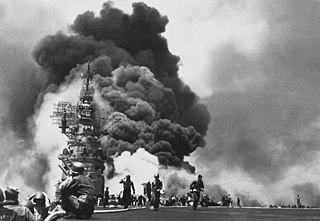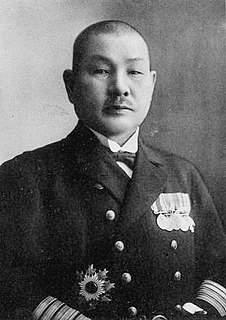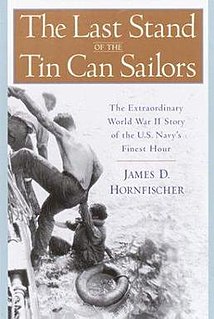 W
WThe Battle of Leyte Gulf is considered to have been the largest naval battle of World War II and, by some criteria, possibly the largest naval battle in history, with over 200,000 naval personnel involved. It was fought in waters near the Philippine islands of Leyte, Samar, and Luzon, from 23 to 26 October 1944, between combined American and Australian forces and the Imperial Japanese Navy (IJN), as part of the invasion of Leyte, which aimed to isolate Japan from the countries it had occupied in Southeast Asia which were a vital source of industrial and oil supplies.
 W
WErnest Edwin Evans was an officer of the United States Navy who posthumously received the Medal of Honor for his actions during the Battle off Samar in World War II.
 W
WI-45 was an Imperial Japanese Navy Type B2 submarine. Completed and commissioned in December 1943, she served in World War II, patrolling in the Pacific Ocean and taking part in the Marianas campaign, the Philippines campaign, and the Battle of Leyte Gulf before she was sunk in October 1944.
 W
WThe second I-54 was an Imperial Japanese Navy Type B3 submarine. Completed and commissioned in March 1944, she served in World War II and took part in the Marianas campaign and the Philippines campaign before she was sunk in October 1944.
 W
WUSS Intrepid (CV/CVA/CVS-11), also known as The Fighting "I", is one of 24 Essex-class aircraft carriers built during World War II for the United States Navy. She is the fourth US Navy ship to bear the name. Commissioned in August 1943, Intrepid participated in several campaigns in the Pacific Theater of Operations, including the Battle of Leyte Gulf.
 W
WOn 17 October 1944, troops of the United States Sixth Army under the direct command of Lieutenant General Walter Krueger, invaded the Philippine island of Leyte. This operation was the beginning of General Douglas MacArthur's fulfillment of his promise in March 1942 to the Filipino people that he would liberate them from Japanese rule.
 W
WKamikaze , officially Shinpū Tokubetsu Kōgekitai , were a part of the Japanese Special Attack Units of military aviators who flew suicide attacks for the Empire of Japan against Allied naval vessels in the closing stages of the Pacific campaign of World War II, intending to destroy warships more effectively than with conventional air attacks. About 3,800 kamikaze pilots died during the war, and more than 7,000 naval personnel were killed by kamikaze attacks.
 W
WThe Battle of Leyte Gulf, generally considered to be the largest naval combat in history, was fought 24–25 October 1944 in the waters of the Philippine Islands by elements of the Imperial Japanese Navy's Combined Fleet and the United States Navy's Pacific Fleet. Of the five separate engagements that made up the battle as a whole, the forces involved in the three principal ones are listed here.
 W
WMusashi (武蔵), named after the former Japanese province, was one of three Yamato-class battleships built for the Imperial Japanese Navy (IJN), beginning in the late 1930s. The Yamato-class ships were the heaviest and most powerfully armed battleships ever constructed, displacing almost 72,000 long tons (73,000 t) fully loaded and armed with nine 46-centimetre (18.1 in) main guns. Their secondary armament consisted of four 15.5-centimetre (6.1 in) triple-gun turrets formerly used by the Mogami-class cruisers. They were equipped with six or seven floatplanes to conduct reconnaissance.
 W
WThe Battle off Samar was the centermost action of the Battle of Leyte Gulf, one of the largest naval battles in history, which took place in the Philippine Sea off Samar Island, in the Philippines on October 25, 1944. It was the only major action in the larger battle in which the Americans were largely unprepared. The Battle off Samar has been cited by historians as one of the greatest last stands in naval history; ultimately the Americans prevailed over a massive armada—the Japanese Imperial Navy's Center Force under command of Vice Admiral Takeo Kurita—despite their very heavy casualties and overwhelming odds.
 W
WThe nonfiction book The Last Stand of the Tin Can Sailors: The Extraordinary World War II Story of the U.S. Navy's Finest Hour is the first full narrative account of the Battle off Samar, which the book's author, James D. Hornfischer, calls the greatest upset in the history of naval warfare. Published by Bantam Books in February 2004, the book won the Samuel Eliot Morison Award for Naval Literature in 2004 from the Naval Order of the United States.